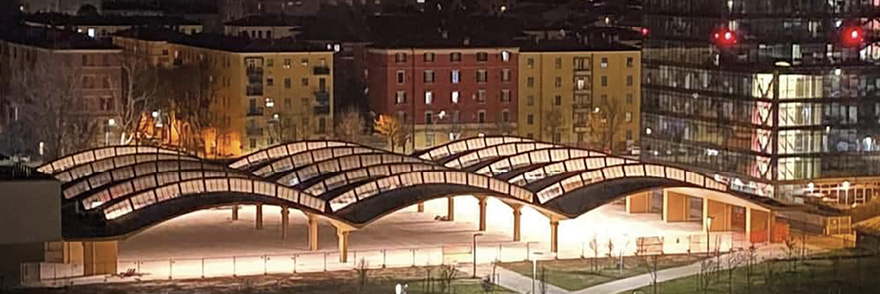Located in the heart of Bologna, Piazza Lucio Dalla is one of the city’s most charming and lively squares. At its centre, stands an icon of modernist architectural design: the Tettoia Nervi, testimony to the genius of Italian architect Pier Luigi Nervi and his innovative vision of design. The history of this canopy begins in the 1950s, when Bologna was trying to rebuild many of the structures damaged during the Second World War. Nervi, known for his mastery in the use of reinforced concrete, was commissioned to design a roof for what is now Piazza Lucio Dalla, which was open land at the time. His idea was bold and revolutionary: a curved concrete structure that would cover the entire square, creating a unique public space. The project was realized between 1952 and 1953, and the Tettoia Nervi soon became a symbol of innovation and modernity. Its undulating shape, supported by slender columns, seemed to defy gravity. Its ingenious design maximized the usable space under the canopy, creating an ideal venue for meetings, cultural events and public events.

Over the decades, the Tettoia Nervi has undergone some restoration work to preserve its structural integrity and timeless beauty, combining form and function in a perfect union capable of expressing the contradictions of the area in which it is located.
Indeed, we are in Bolognina, on the outskirts of Bologna, an area that has undergone a process of urban and social regeneration in recent years, with Via Fioravanti as one of the main focal points of this process. However, while there are undoubted benefits from this regeneration, there are also critical aspects that deserve attention. Among the positive aspects, the regeneration has contributed to the improvement of the physical appearance of the area and increased participation of residents in the life of the neighbourhood, which has positively contributed to the attractiveness of the area and the creation of economic opportunities.
However, there are some challenges and critical issues related to this process. A major concern is the possible increase in housing costs because of gentrification. As a result of regeneration, the area could become more attractive to newcomers with higher purchasing power, leading to an increase in housing prices and rents, which could exclude low-income residents.

Another critical issue is the preservation of the cultural identity of the neighbourhood. Gentrification could lead to a loss of Bolognina’s historical and cultural roots, as new influences and populations may affect the local community, changing the social fabric of the neighbourhood. One example is the dismantling of the XM24 social centre, which, until 2019, was a hub of cultural and social activities with a prominent role and active involvement within the Bolognese community. However, it is crucial to carefully address the challenges of gentrification, cultural preservation, and resident inclusion to ensure that this transformation is truly positive for all members of the community. Careful management and active community involvement can help maximize the benefits and minimize the drawbacks of this process.




.png)